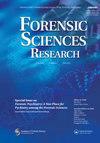Recent Case Reveals a Nineteenth Century Trauma Analysis and Presentation of a Skull as Evidence in a Homicide Trial
IF 1.4
4区 医学
Q3 MEDICINE, LEGAL
引用次数: 0
Abstract
Following a recent death, a human skull was found in a worn physician bag at the decedent’s residence. The bag was labeled with the name “G.B. Ward”, who was found to be a practicing physician and surgeon in the late 1800s, and contained historic medical paraphernalia and letters and receipts dated to the late 1890s. A forensic anthropological analysis of the skull concluded that it was not of modern medicolegal significance but revealed certain inconsistencies with standard professionally prepared anatomical specimens. This initiated further investigation into the history of G.B. Ward, which ultimately resulted in the circumstantial identification of the skull and revealed more than forty detailed newspaper accounts of its evidentiary use in an 1895 homicide trial in the rural United States. Ultimately, the Prosecution’s argument was likely based on the misinterpretation of a transmaxillary (Le Fort) fracture, which had yet to be defined in the medical literature. This case study emphasizes the importance of investigative and forensic anthropological efforts and cautions against cursory designations of skeletal remains as medical specimens. It also highlights the early recognition of the evidentiary value of skeletal remains in court cases and pioneering efforts in performing forensic skeletal trauma analyses.最近的一个案例揭示了19世纪的创伤分析,并在杀人案审判中提出了头骨作为证据
在最近的一起死亡事件中,在死者住所的一个破旧的医生包里发现了一个人类头骨。袋子上贴着“G.B.”的标签在19世纪后期,他被发现是一名执业内科医生和外科医生,里面有历史悠久的医疗用具,以及19世纪90年代末的信件和收据。对头骨进行的法医人类学分析得出的结论是,它不具有现代医学意义,但与标准的专业解剖标本存在某些不一致之处。这引发了对G.B.沃德历史的进一步调查,最终导致了对头骨的间接鉴定,并揭示了在1895年美国农村一起谋杀案审判中使用头骨作为证据的四十多份详细的报纸报道。最终,控方的论点可能是基于对经上颌骨折(Le Fort)的误解,这在医学文献中尚未得到定义。本案例研究强调了调查和法医人类学工作的重要性,并告诫不要草率地将骨骼遗骸指定为医学标本。它还强调了在法庭案件中早期认识到骨骼遗骸的证据价值,以及在进行法医骨骼创伤分析方面的开创性努力。
本文章由计算机程序翻译,如有差异,请以英文原文为准。
求助全文
约1分钟内获得全文
求助全文

 求助内容:
求助内容: 应助结果提醒方式:
应助结果提醒方式:


